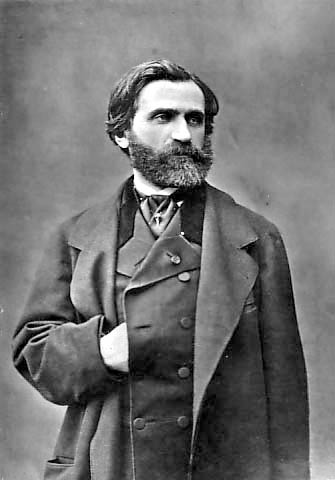Giuseppe Verdi (1813-1901)
Born October 10, 1813 in Le Roncole, Parma.
Died January 27 1901 in Milan.
La forza del destino Overture
Composed 1861-1862, revised 1869.
First Performance: (Opera) November 10, 1862, Bolshoi Kamenny Theatre, St. Petersburg, this overture February 20, 1869 at La Scala, Milan.
Instrumentation: piccolo, flute, 2 oboes, 2 clarinets, 2 bassoons, 4 horns, 2 trumpets, 3 trombones, tuba, 2 harps, timpani, percussion, and strings.
In 1860 Giuseppe Verdi who was already rich and internationally famous, was considering retirement. The famous Italian Tenor Enrico Tamberlik asked Verdi to compose an opera for his upcoming engagement in St. Petersburg. The initial run of this opera – La forza del destino (The force of destiny) – was less than successful. The audiences reacted against the absurd violent plot which was worthy of treatment by Quentin Tarentino (plot summary: everyone dies) and perhaps were also put off by a foreign composition in an atmosphere of growing Russian nationalism.
Later Verdi revised the opera, removing some deaths along with many musical revisions which included discarding the original short prelude. The present overture is from this revision which received its premiere at La Scala on February 20th, 1869. In this overture we hear previews of several hit songs from the opera such as Leonora’s Prayer from Act II.
The overture begins with the brass section intoning the “fate motif” which is a unison E played three times. The motif is repeated and then the strings enter with an agitated motif that appears both in the foreground and background throughout the work.
Example 1. Agitato theme
The fate motif returns followed by an andantino theme in the woodwinds while we hear echoes of the agitato theme in the strings. This is from the Act 3 duet between Don Alvaro and Leonora’s brother Don Carlo.
Example 2. Andantino
Then, very quietly (ppp) we hear an andante third theme emerge from the strings. This is Leonora’s prayer from Act II. She is preparing to spend the rest of her life atoning for her sin. The agitato theme is still there in the background.
Example 3. Andante mosso (strings)
The agitato theme comes to the foreground, is briefly developed then subsides with snippets of the andantino theme. We then hear the clarinets quietly introduce the final important theme. This is from Act II when Leonora retires to a cave in the forest dressed as a hermit.
Example 4. Allegro brillante (clarinet)
We then hear various settings of these themes including an interesting chorale like setting for the brass section. The agitato theme brings us to the climax where then andante theme is played fortissimo by the winds and strings. A brilliant coda which intertwines all of the themes brings the overture to a stirring conclusion.
Resources
[amazon template=iframe image&asin=B00UJ2DDZS][amazon template=iframe image&asin=3795761247][amazon template=iframe image&asin=076928518X]
Public domain score.
[amazon template=iframe image&asin=B000001GYB][amazon template=iframe image&asin=B001BKNU0U]




